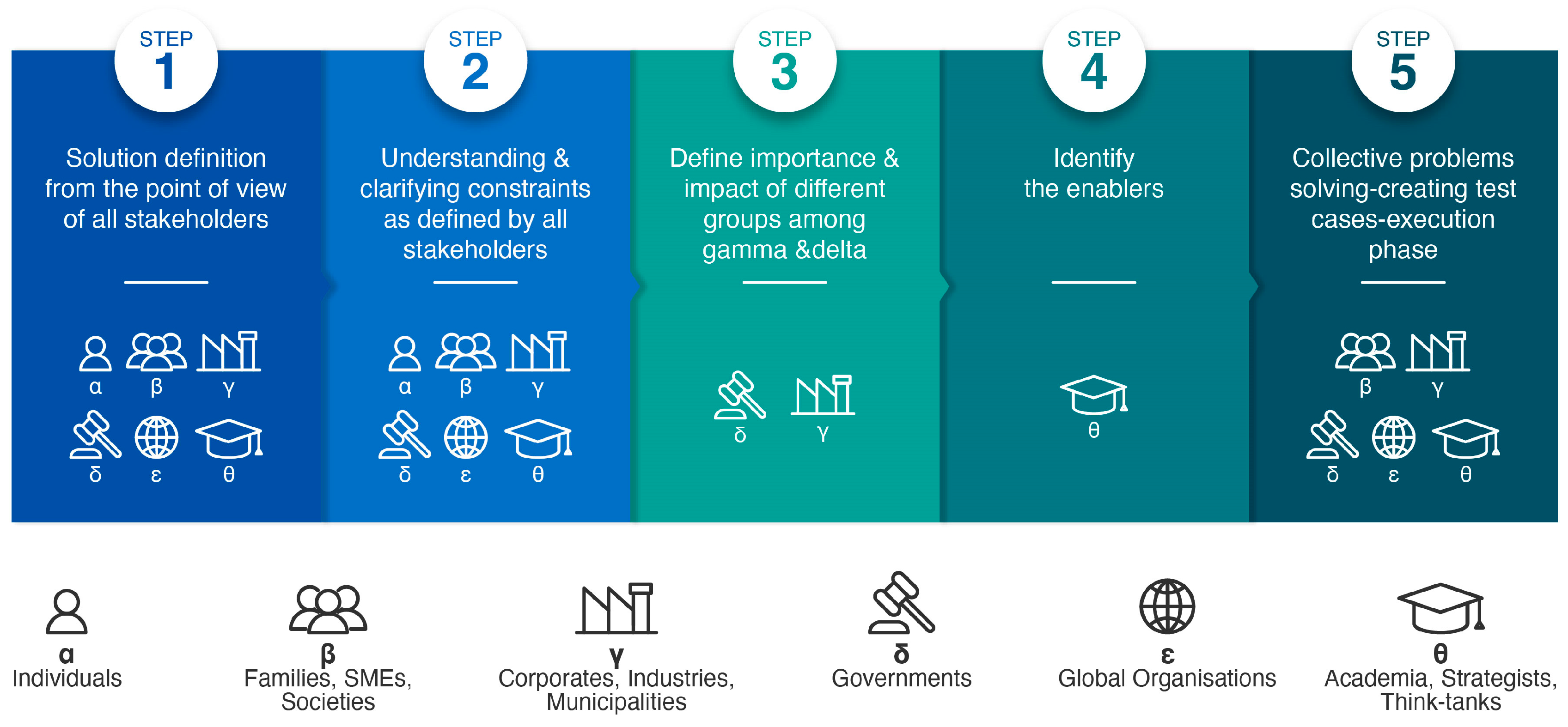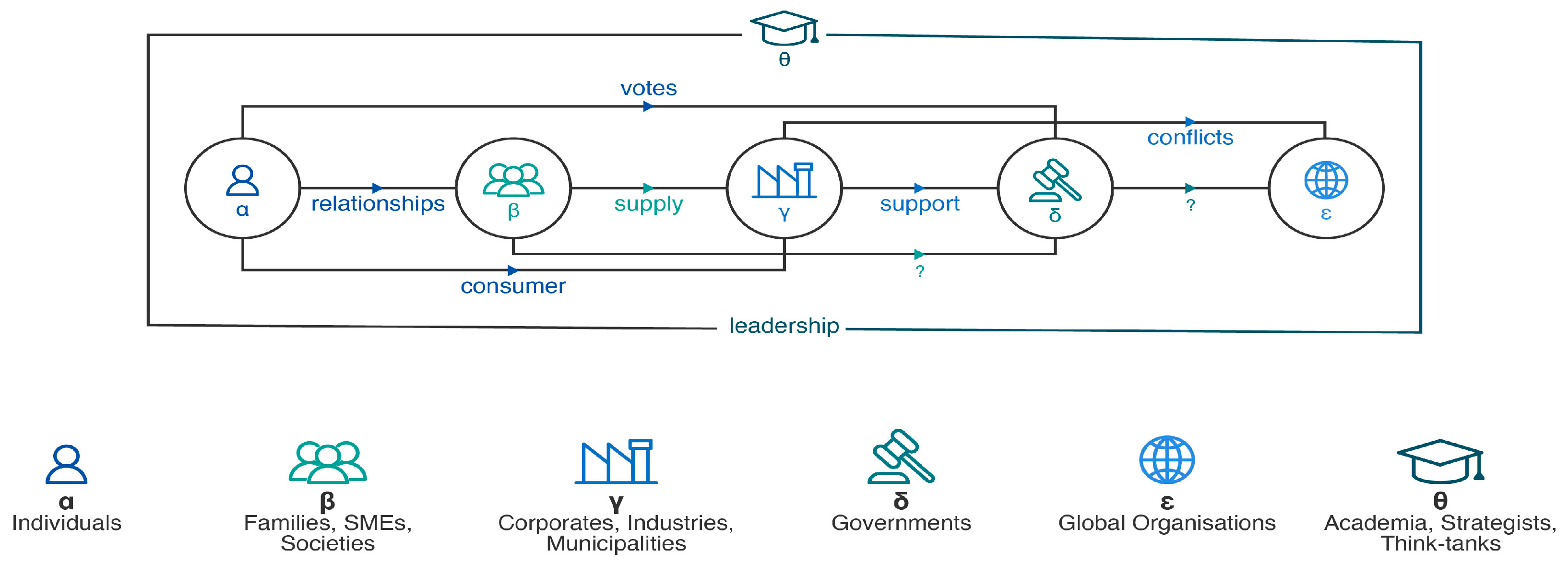A Transdisciplinary Approach and Design Thinking Methodology: For Applications to Complex Problems and Energy Transition
Abstract
1. Introduction and Conceptual Definitions
1.1. Multidisciplinary, Interdisciplinary, and Transdisciplinary Approaches
1.2. Design Thinking Methodology
2. Methodology
A General Discussion to Tackle Complex Problems
3. Energy Transition and Climate Crisis as Complex Problems
4. Case Studies
4.1. Case Study 1: Application to Medical Process Development by Following the TADTM
- (a)
- Identify the problem: This step is the most challenging. From the top decisionmaker to the engineers in product development, engagement, and a willingness to try a new methodology had to be ensured. As can be expected, there were many pushbacks and much resistance.
- (b)
- Identify and engage all stakeholders: Engineers, product managers, marketing and sales teams, executives, clinicians, and patients were involved. Our first kick-off workshop in-house without the clinicians and patients had over 150 members of product teams. It lasted a full day and was a big investment for the company.
- (c)
- Carry out continuous field observation trips and in-depth discussion sessions using design tools and DTM.
- (d)
- Try out ideas with prototypes and test.
- (e)
- Measure impact versus the previous state: Our goal was to improve access and quality of healthcare while decreasing costs for the healthcare system. The data collected have been a great way to keep teams engaged.
- (f)
- Get continuous feedback from all stakeholders, and particularly from patients, to continually improve the product.
4.2. Case Study 2: Achieving Energy Efficiency at a University Campus by Integrated Studies
4.3. Case Study 3: TUSIAD-CEEE Joint Industrial Energy Efficiency Initiative
5. Concluding Remarks
Author Contributions
Funding
Acknowledgments
Conflicts of Interest
References
- Eppel, E.A.; Rhodes, M.L. Complexity theory and public management: A “becoming” field. Public Manag. Rev. 2018, 20, 949–959. [Google Scholar] [CrossRef]
- Scholz, R.W.; Spoerri, A.; Lang, D.J. Problem structuring for transitions: The case of Swiss waste management. Futures 2009, 41, 171–181. [Google Scholar] [CrossRef]
- IPCC. 2022: Summary for Policymakers. In Climate Change 2022: Impacts, Adaptation and Vulnerability. Contribution of Working Group II to the Sixth Assessment Report of the Intergovernmental Panel on Climate Change; Pörtner, H.-O., Roberts, D.C., Tignor, M., Poloczanska, E.S., Mintenbeck, K., Alegría, A., Craig, M., Langsdorf, S., Löschke, S., Möller, V., et al., Eds.; Cambridge University Press: Cambridge, UK; New York, NY, USA, 2022; pp. 3–33. [Google Scholar] [CrossRef]
- International Energy Agency (IEA). World Energy Outlook. 2022. Available online: https://iea.blob.core.windows.net/assets/830fe099-5530-48f2-a7c1-11f35d510983/WorldEnergyOutlook2022.pdf (accessed on 28 February 2024).
- United Nations Climate Action. Available online: https://www.un.org/en/climatechange/what-is-climate-change (accessed on 28 February 2024).
- McKinsey & Company. The Energy Transition: A Region-by-Region Agenda for Near-Term Action. 2022. Available online: https://www.mckinsey.com/industries/electric-power-and-natural-gas/our-insights/the-energy-transition-a-region-by-region-agenda-for-near-term-action (accessed on 28 February 2024).
- International Energy Agency (IEA). Energy Efficiency 2022, December 2022. Available online: https://www.iea.org/reports/energy-efficiency-2022 (accessed on 28 February 2024).
- Ghodsvali, M.; Krishnamurthy, S.; de Vries, B. Review of Transdisciplinary Approaches to Food-water-energy Nexus: A Guide Towards Sustainable Development. Environ. Sci. Policy 2019, 101, 266–278. Available online: https://www.sciencedirect.com/science/article/pii/S1462901119304502 (accessed on 28 February 2024). [CrossRef]
- Wikipedia, Transdisciplinarity. 2023. Available online: https://en.wikipedia.org/w/index.php?title=Transdisciplinarity&oldid=1131189535 (accessed on 28 February 2024).
- Choi, B.C.; Pak, A.W. Multidisciplinarity, interdisciplinarity, and transdisciplinarity in health research, services, education, and policy: 1. Definitions, objectives, and evidence of effectiveness. Clin. Invest. Med. 2006, 29, 351–364. [Google Scholar] [PubMed]
- Klein, J.T. Evaluation of interdisciplinary and transdisciplinary research: A literature review. Am. J. Prev. Med. 2008, 35 (Suppl. S2), S116–S123. [Google Scholar] [CrossRef] [PubMed]
- Roderick, J.L. Deciphering Interdisciplinary and Transdisciplinary Contributions. Transdiscipl. J. Eng. Sci. 2010, 1, 125–130. [Google Scholar]
- Harvard Transdisciplinary Research in Energetics and Cancer Center. Boston, 677 Huntington Avenue, 02115 +1495-1000. “Definitions”. 2012. Available online: https://www.hsph.harvard.edu/trec/about-us/definitions/ (accessed on 28 February 2024).
- Caiado, F.; Springer, L. Contributions of Design Thinking in Inter and Transdisciplinary Communication, Research & Co-work Environment for Complex Problem Solving. IMCIC 2022, 20, 45–50. [Google Scholar] [CrossRef]
- Mengüç, M.P. From Nano to Giga: Research and Applications. In CEEE/EÇEM 10+th Yearbook; Ozyegin University Press: Çekmeköy, İstanbul, August 2021; Available online: https://www.ozyegin.edu.tr/pdfviewer/CEEE-FromNanoToGiga.php (accessed on 28 February 2024).
- Feigen, M.A.; Jenkins, M.; Varendh, A. “Is It Time to Consider Co-CEO’s” Harvard Business Review. July–August 2022. Available online: https://hbr.org/2022/07/is-it-time-to-consider-co-ceos (accessed on 28 February 2024).
- The Interaction Design Foundation. What Is Design Thinking? Available online: https://www.interaction-design.org/literature/topics/design-thinking (accessed on 8 January 2023).
- Yahyaoui, S. The Design Thinking Toolkit: 100+ Method Cards to Create Innovative Products. 2020. Available online: https://uxplanet.org/the-design-thinking-toolbox-100-tools-to-create-innovative-products-50ede1f5e3cl (accessed on 28 February 2024).
- Hedberg, A.; Cunningham, T.; Nazakat, S.; Yao, L. Germany’s Energy Transition: From a Vision to Strategy, Assessing Energiewende. Konrad Adenauer Stiftung. 2018, pp. 10–15. Available online: https://www.jstor.org/stable/resrep17543.5 (accessed on 28 February 2024).
- German Energy Agency, Dena. Integrated Energy Transition Report; German Energy Agency, Dena: Berlin, Germany, 2018. [Google Scholar]
- McKinsey & Company. Germany’s Energy Transition at a Crossroads. 21 November 2019. Available online: https://www.mckinsey.com/industries/electric-power-and-natural-gas/our-insights/germanys-energy-transition-at-a-crossroads (accessed on 28 February 2024).
- Jakimowicz, A.; Rzeczkowski, D. Contact Zones in the Energy Transition: A Transdisciplinary Complex Problem. Energies 2023, 16, 3560. [Google Scholar] [CrossRef]
- Tushar, W.; Lan, L.; Withanage, C.; Sng, H.E.K.; Yuen, C.; Wood, K.L.; Saha, T.K. Exploiting design thinking to improve energy efficiency of buildings. Energy 2020, 197, 117141. Available online: https://www.sciencedirect.com/science/article/pii/S0360544220302486 (accessed on 28 February 2024). [CrossRef]
- GE Adventure Series. Available online: https://www.gehealthcare.com/products/imaging-accessories/adventure-series-for-ct (accessed on 28 February 2024).
- Kumar, V.; Rangan, V.K. Healthymagination at GE Healthcare Systems; Harvard Business School: Boston, MA, USA, 1 November 2011; N9-512-039; pp. 8–11. Available online: https://www.hbs.edu/faculty/Pages/item.aspx?num=41085 (accessed on 28 February 2024).
- Pineo, H.; Turnbull, E.R.; Davies, M.; Rowson, M.; Hayward, A.C.; Hart, G.; Johnson, A.M.; Aldridge, R.W. A New Transdisciplinary Research Model to Investigate and Improve the Health of the Public. Health Promot. Int. 2021, 36, 481–492. [Google Scholar] [CrossRef] [PubMed]
- Stokols, D.; Hall, K.; Vogel, A. Transdisciplinary public health: Definitions, core characteristics, and strategies for success. In Transdisciplinary Public Health: Research, Methods, and Practice; Joshu, D., McBride, T.D., Eds.; Jossey-Bass Publishers: San Francisco, CA, USA, 2013; pp. 3–30. [Google Scholar]
- Keskin, C.; Mengüç, M.P. On Occupant Behavior and Innovation Studies Towards High Performance Buildings: A Transdisciplinary Approach. Sustainability 2018, 10, 3567. [Google Scholar] [CrossRef]
- International Energy Agency (IEA). Turkey Energy Review. 2021. Available online: https://www.iea.org/reports/turkey-2021 (accessed on 28 February 2024).
- Republic of Türkiye, Ministry of Energy and Natural Resources, Energy Efficient Technologies Report for Industrial Sectors. 2020. Available online: https://enerji.gov.tr//Media/Dizin/EVCED/tr/Belgeler/963109-sanayide_enerji_verimli_teknolojiler.pdf (accessed on 28 February 2024).


Disclaimer/Publisher’s Note: The statements, opinions and data contained in all publications are solely those of the individual author(s) and contributor(s) and not of MDPI and/or the editor(s). MDPI and/or the editor(s) disclaim responsibility for any injury to people or property resulting from any ideas, methods, instructions or products referred to in the content. |
© 2024 by the authors. Licensee MDPI, Basel, Switzerland. This article is an open access article distributed under the terms and conditions of the Creative Commons Attribution (CC BY) license (https://creativecommons.org/licenses/by/4.0/).
Share and Cite
Ozsoy, C.M.; Mengüç, M.P. A Transdisciplinary Approach and Design Thinking Methodology: For Applications to Complex Problems and Energy Transition. World 2024, 5, 119-135. https://doi.org/10.3390/world5010007
Ozsoy CM, Mengüç MP. A Transdisciplinary Approach and Design Thinking Methodology: For Applications to Complex Problems and Energy Transition. World. 2024; 5(1):119-135. https://doi.org/10.3390/world5010007
Chicago/Turabian StyleOzsoy, Canan M., and M. Pinar Mengüç. 2024. "A Transdisciplinary Approach and Design Thinking Methodology: For Applications to Complex Problems and Energy Transition" World 5, no. 1: 119-135. https://doi.org/10.3390/world5010007
APA StyleOzsoy, C. M., & Mengüç, M. P. (2024). A Transdisciplinary Approach and Design Thinking Methodology: For Applications to Complex Problems and Energy Transition. World, 5(1), 119-135. https://doi.org/10.3390/world5010007







